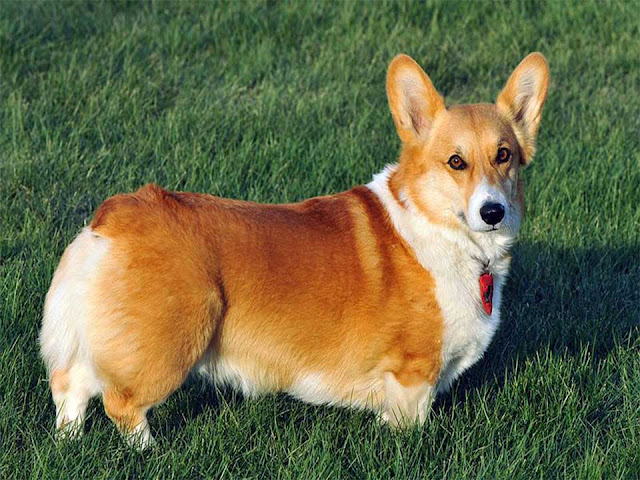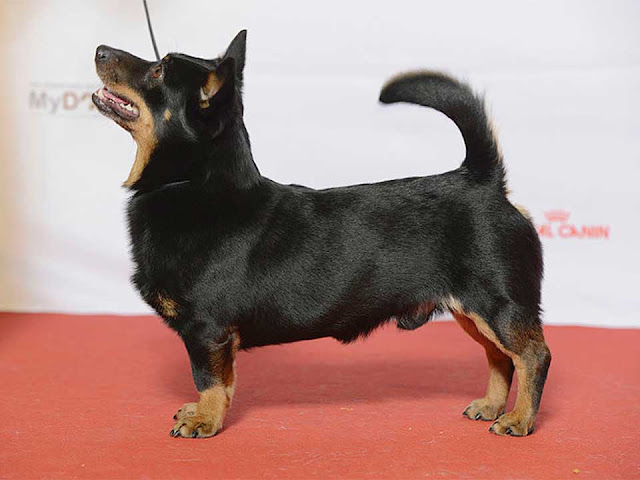Lancashire Heeler

Lancashire Heeler is a small-sized dog breed, originally bred in the United Kingdom for the purpose to drove and herd cattle. Lancashire Heeler is registered as a vulnerable breed by the Kennel Club of United Kingdom.
Weight and Height
Lancashire Heeler is slightly longer than the height at withers, usually weighs 13 to 18 pounds (5.9 to 8.2 kg), and measures between 10 to 12 inches (25 to 30 cm) at the shoulder.
Life Expectancy
The average life of Lancashire Heeler is expected to be 12 to 15 years.
Coat and Colors
Lancashire Heeler has a harsh and smooth coat with a basecoat that keeps the dog dry in all weather conditions. The dog may have a small mane around the neck in winter. Lancashire Heeler is usually found in black and tan colors, but now liver and tan colors are also accepted by the kennel club. The ears can be tipped or erect.
Temperament
Lancashire Heeler is an intelligent, friendly, active, playful and good companion dog. The personality of dog can range from lazy and playful to energetic and loquacious. Lancashire Heeler is a very strong dog which likes to perform all types of activities. The dog is friendly to its owners and passers-by on the street but can be aggressive to an unfamiliar character in its terrain. Lancashire Heeler is good for apartment life. The dog is very active indoors and is suitable without a courtyard if properly trained. The breed is good with the children, being playful, active, and affectionate around them.
Activities
Being a playful and energetic dog, Lancashire Heelers can participate in all dog events, such as dog agility trials, flyball, obedience, Rally obedience, herding, and showmanship. The herding instincts and trainability can be measured at noncompetitive herding trials. Lancashire Heelers showing rudimentary herding instincts can be trained to participate in herding tests.
Grooming and Training
Lancashire Heeler is easy to groom, for example, comb and brush as well as bathe only when necessary. The coat of Lancashire Heeler should be seasonable; long or short. In the winter season, it should be luxurious with a visible mane; but sleek, shiny in the summers. Lancashire Heeler can be difficult to train but it is possible only by a confident and reliable trainer.
Health Conditions
The three most common diseases, Lancashire Heelers can suffer include Collie eye anomaly, Primary lens luxation, and Persistent pupillary membranes. In addition to these eye conditions, Lancashire Heelers may suffer from Patella Luxation.
History
The exact details of the origin are unknown for this breed. Though it is believed that a type of Welsh Corgi was used to herd cattle to the northwest of England from Wales. Later, a black and tan colored terrier named “Manchester Terrier” was introduced in the Ormskirk area which then resulted in existing Lancashire Heeler. The breed is renowned in its home-county for over 150 years as a general purpose farm-dog, which is accomplished with both ratting and herding livestock.
In the early 1960s, Gwen Mackintosh started breeding Heelers. Later in 1978, she established a “Lancashire Heeler Club” together with other aficionados and introduced a breed standard with registration. Recognition by the ‘Kennel Club’ was followed in 1981. Mackintosh served as a president of the club until her death in 1992.
In 2006, the breed was accepted as a vulnerable native breed by the Kennel Club, then annual registration number was 300 or less for the breed. In 2006, 173 Heelers were listed in the United Kingdom and this figure decreased up to 146 in 2007. In 2016, the Fédération Cynologique Internationale (FCI) added this breed to the provisionally accepted breeds list.



